
Asclepias amplexicaulis (Bluntleaf Milkweed)
 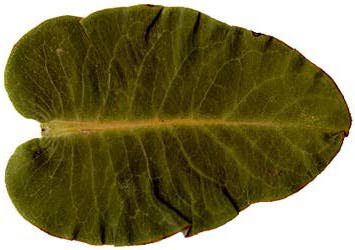 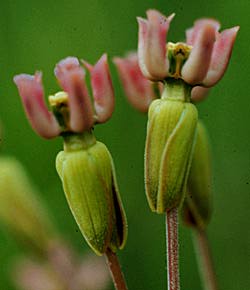  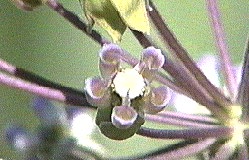  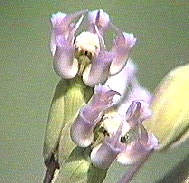
- Perennial herb from a deep rhizome
- 4-8 dm tall
- Leaves mostly opposite; 4-12 cm long, 1.8-8 cm wide
- Flowers: green and purple tinged
- Habitat: Sandy soils of prairies and roadsides
- Distribution: s ND, NE, CO, KS, cen 1/3 OK, TX, e NM (Great Plains s to cen TX & s NM; n Mex.)
Text from: Great Plains Flora Association, 1986. Flora of the Great Plains. University Press of Kansas.
Apocynum cannabinum (Indian Hemp Dogbane)
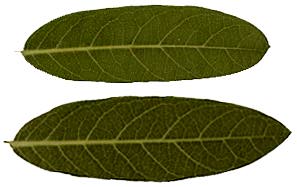
This plant is frequently mistaken for milkweed because of its milky sap and general similarity to Asclepias syriaca, especially in early spring. Although Monarch larvae will take a few nibbles of Apocynum leaves, they are unable to continue feeding on the plant and invariably die.
Text from: Great Plains Association, 1986. Flora of the Great Plains. University Press of Kansas.
Asclepias arenaria (Sand Milkweed)
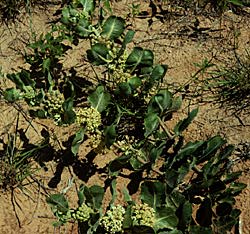  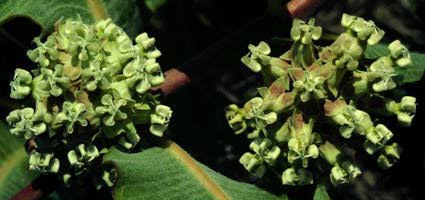
- Perennial herb, stems relatively stout, usually simple
- leaves opposite, 6-9 cm long, 4-8 cm wide
- Flowers:Inflorescences lateral and solitary at upper nodes, flowers rather large, pale green/white or cream, blooming from May to August
- Habitat: Sandy soil, spreading to roadsides
- Distribution:SD to TX and westward to CO and NM; Chihuahua
Text from: R.E. Woodson Jr., 1954. North American Species of Asclepias. Annals of the Missouri Botanical Garden.
Asclepias asperula (Antelope Horns)
 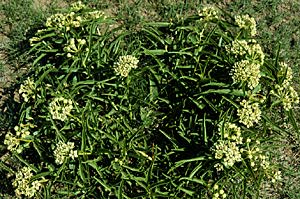 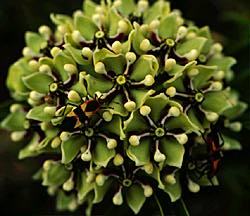 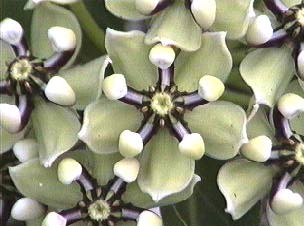 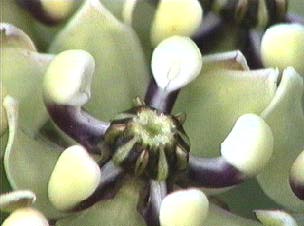
- Low perennial herb from very stout rootstock, stems usually clustered from the rootstock, simple, rather stout
- 2-6 dm tall
- Leaves irregularly approximate; 10-20 cm long, 1-3cm wide
- Flowers:Inflorescences solitary and terminal, usually very crowded, flowers rather large, pale yellowish green sometimes tinged with purple, blooming from March to August
- Habitat:Flats and desert swales, sandy and rocky hillsides, with pinyon, juniper, oak, mesquite, Yucca, and Nolina
- Distribution:CO and w TX to UT, AZ, NV, and adjacent ID and CA; Tamaulipas westward to Sonora and southward to Hidalgo and San Luis Potosi
Text from: R.E. Woodson Jr., 1954. North American Species of Asclepias Annals of the Missouri Botanical Garden.
Calotropis procera (Calotrope)
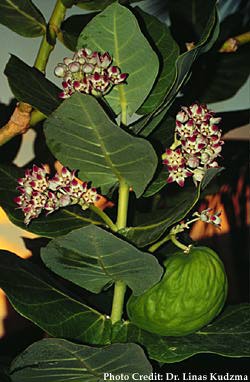 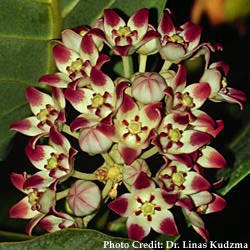 
This African milkweed species is widely distributed throughout the Caribbean and is known to be used by Monarchs. Calotrope is commonly harvested for its medicinal properties.
Asclepias curassavica (Tropical Milkweed)
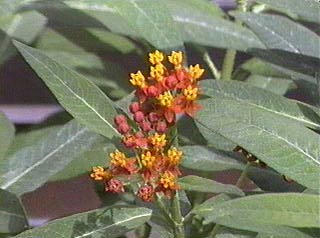 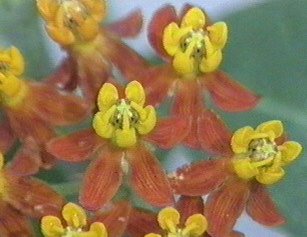 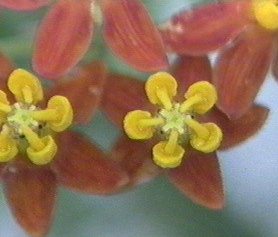  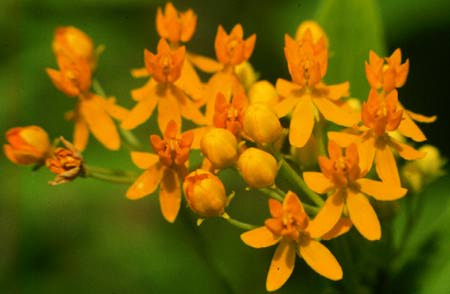
- Perennial herb
- Flowers: reddish orange and yellow; commonly visited by butterflies, moths, bees,wasps, flies, and beetles
- Habitat: roadsides and pastures
- Distribution: widely distributed in the Neotropics and subtropics, from near sea level to about 2,000 m
Text from: D.H. Janzen, ed.Costa Rican Natural History, 1983. The University of Chicago Press.
* Silky gold curassavica is believed a to be a cultivar of A. curassavica
Cynanchum laeve (Sand Vine [Blue Vine] Milkweed)
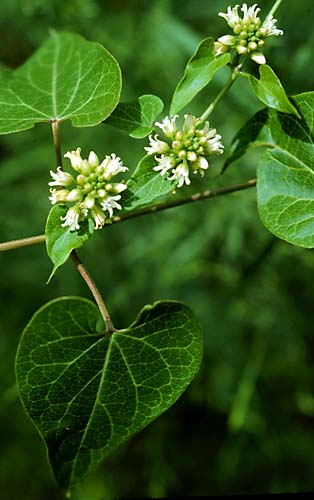 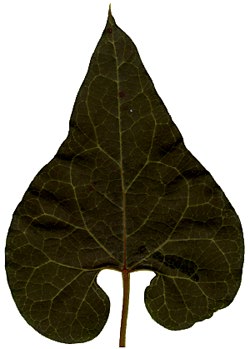
- Perennial trailing vine
- Leaves opposite; 4-11cm long, 2-10cm wide; heart-like shape
- Flowers: whitish to cream
- Habitat: Sandy, clayey, or rocky calcareous soils of forest margins, thickets, flood plains, or disturbed areas
- Distribution: sw IA, MO, e edge NE, e 2/3 KS, e OK; (PA to NE, s to GA & TX)
Text from: Great Plains Association, 1986. Flora of the Great Plains. University Press of Kansas.
Asclepias engelmanniana (Engelmann's Milkweed)
 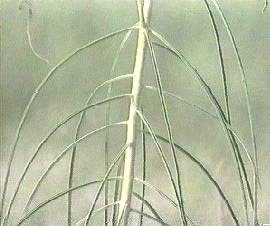  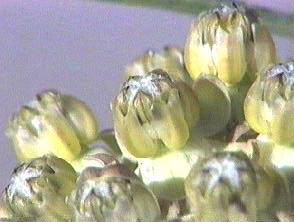 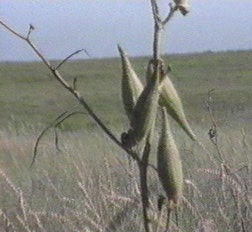
- Perennial herb from a rhizome
- 3-12dm tall
- Leaves alternate; 10-12cm long, 1-5mm wide
- Flowers: pale green tinged with purple
- Habitat: Sandy or rocky calcareous soils of prairies, breaks, or flood plains
- Distribution: NE, KS, CO, OK, TX, NM; (Great Plains w to se UT & s to s TX & s AZ; n Mex.)
Text from: Great Plains Association, 1986. Flora of the Great Plains. University Press of Kansas.
Asclepias fascicularis (Narrowleaf Milkweed)

- Perennial herb from stout woody rootstock
- 4-10dm tall
- Leaves 3-nate or 4-nate; 3-12cm long, 0.1-2.5cm wide
- Flowers: Inflorescences paired or clustered at uppermost nodes, flowers rather small, usually grayish pink, infrequently white, blooming from May to October
- Habitat: Plains, hills, and valleys, in moist or dry soil, spreading to roadsides and waste places
- Distribution: ID, UT, and NV westward to the Pacific coast, northern Baja California
Text from: R.E. Woodson Jr., 1954. North American Species of Asclepias. Annals of the Missouri Botanical Garden.
Asclepias hirtella (Prairie Milkweed)
  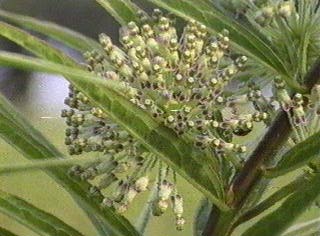 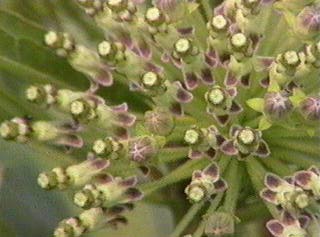
- Perennial herb from a thickened taproot and possibly a rhizome
- 2.5-11dm tall
- Leaves mostly alternate, 4-14cm long, 0.3-0.7cm wide
- Flowers: pale green tinged with purple
- Habitat:Sandy or rocky, calcareous soils of prairies ans marshy areas
- Distribution: IA, MO, e KS, e OK; (s Can., MI to MN, KS, s to WV & OK)
Text from: Great Plains Association, 1986. Flora of the Great Plains. University Press of Kansas.
Asclepias incarnata (Swamp Milkweed)
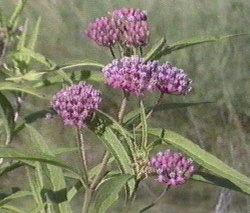  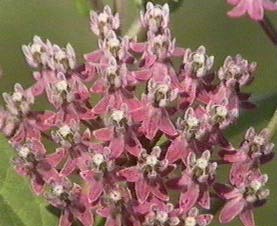 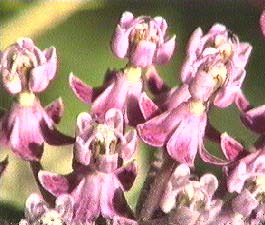
- Perennial herb with shallow, fibrous root system
- 7-20 dm tall
- Leaves mostly opposite; 5-15cm long, 1-3cm wide
- Flowers: bright pink or, rarely, white
- Habitat: Banks and flood plains of lakes, ponds, and waterways, marshes, swamps , and other wet areas of prairies
- Distribution: Great Plains except w ND, nw SD, MT; (s Can., ME to ND, s to FL & NM)
Text from: Great Plains Association, 1986. Flora of the Great Plains. University Press of Kansas.
Asclepias latifolia (Broadleaf Milkweed)
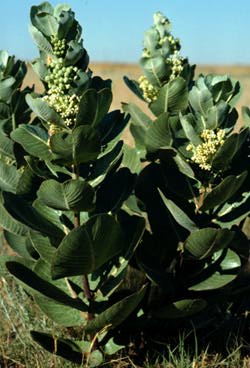 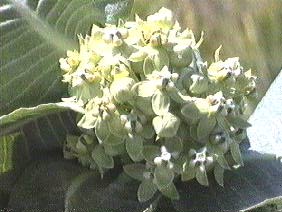 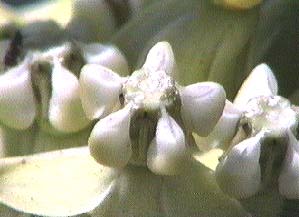
- Perennial herb from a deep rootstock
- 3-6dm tall
- leaves opposite, 6-15cm long, 4-12cm wide
- Flowers: greenish
- Habitat: Sandy, clayey, or rocky calcareous soils of prairies & breaks
- Distribution: s edge NE, w 2/3 KS, CO, w 1/2 OK, TX, NM; (Great Plains w to e CA, s to s-cen TX & s AZ)
Text from: Great Plains Association, 1986. Flora of the Great Plains. University Press of Kansas.
Asclepias meadii (Mead's Milkweed)
 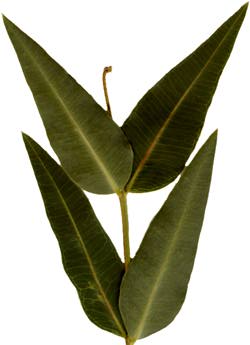 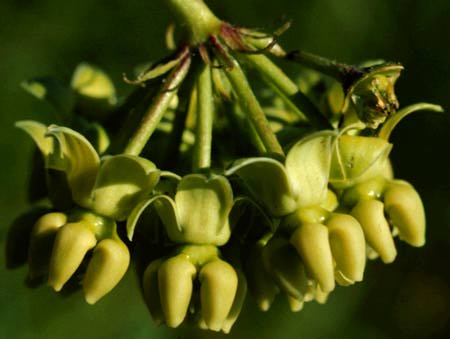 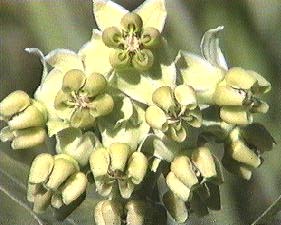 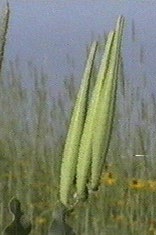
- Perennial herb from a slender rootstock, stems rather slender, simple
- 2-4dm tall
- Leaves opposite; 5-7cm long, 1-5cm wide
- Flowers: Inflorescences solitary and terminal, flowers rather large, greenish cream tinged with purple, blooming from May to June
- Habitat: Dry upland prairies and chert-lime glades, very scattered and rare
- Distribution: s WI and n IL westward to MO and e KS
Text from: R.E. Woodson Jr., 1954. North American Species of Asclepias. Annals of the Missouri Botanical Garden.
Asclepias ovalifolia (Oval Leaf Milkweed)
 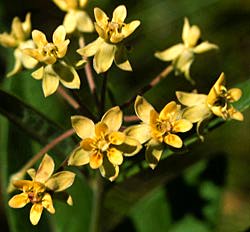
- Perennial herb, stems relatively slender
- 1-3dm tall
- Leaves opposite; 3-7cm long, 1.5-4.0cm wide
- Flowers: Inflorescences usually solitary and terminal, flowers rather small, greenish white and tinged with purple, blooming from May to July
- Habitat: Sandy prairies and open woods, gravely knolls, spreading to railways
- Distribution: WI and n IL westward to the Dakotas; s Manitoba and Saskatchewan
Text from: R.E. Woodson Jr., 1954. North American Species of Asclepias. Annals of the Missouri Botanical Garden.
Asclepias pumila (Plains Milkweed)
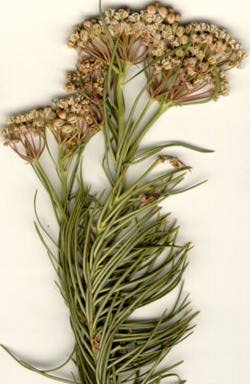 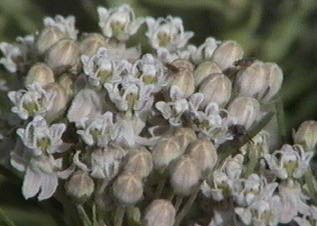 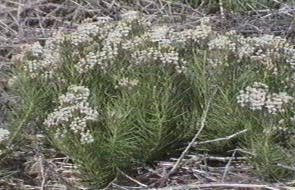
- Perennial herb from a taproot or slender rhizome
- 5-3 dm tall
- Leaves alternate; 1.5-5 cm long, 0.5-1 cm wide
- Flowers: white
- Habitat: Sandy, clayey, or rocky calcareous or gypseous soils of prairies
- Distribution: Great Plains except MN, IA, MO, e 1/3 KS, e 1/2 OK; (Great Plains s to trans-Pecos TX)
Text from: Great Plains Association, 1986. Flora of the Great Plains. University Press of Kansas.
Asclepias purpurascens (Purple Milkweed)
 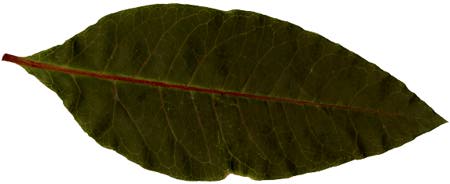 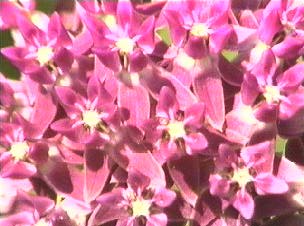 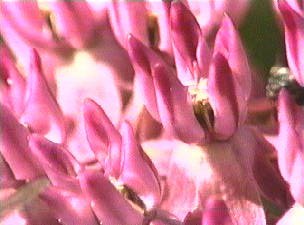
- Perennial herb from a slender to stout rhizome
- 5-10 dm tall
- Leaves opposite, 8-23 cm long, 4-10 cm wide
- Flowers: deep purplish-red
- Habitat: Sandy or rocky calcareous soils of open deciduous woodlands
- Distribution: Great Plains except IA, MO, e edge KS (also Wallace Co.), e edge OK; (CT & NC w to Great Plains, s to AR)
Text from: Great Plains Association, 1986. Flora of the Great Plains. University Press of Kansas.
Asclepias quadrifolia (Four-Leaf Milkweed)
 
- Perennial herb from long and fleshy rootstock, stems slender
- 2-5 dm tall
- leaves usually opposite but clustered to form a false whorl, 2.5-12.0 cm long, 1-6 cm wide
- Flowers: Inflorescences usually solitary and terminal, flowers rather small, pale pink or cream, blooming from April to July
- Habitat: Woods and thickets, usually rather dry and rocky
- Distribution: sw VT to ne AL and westward to se IN; IA, AR, & adjacent IL, OK, & KS; se Ontario
Text from: R.E. Woodson Jr., 1954. North American Species of Asclepias. Annals of the Missouri Botanical Garden.
Sarcostemma cynanchoides (Arroyo Twine Vine)

- Perennial twining or trailing vine
- Leaves opposite; 1-7 cm long, .5-6.0 cm wide
- Flowers: Inflorescences few to many, flowers 11-15 mm in diameter, green to purple-tinged, greenish white and tinged with purple, blooming from June to September
- Habitat: Sandy or rocky soils of thickets and forest margins
- Distribution: OK, TX (western Great Plains to NM and AZ; n Mexico)
Text from: Great Plains Association, 1986. Flora of the Great Plains. University Press of Kansas.
Asclepias speciosa (Showy Milkweed)
 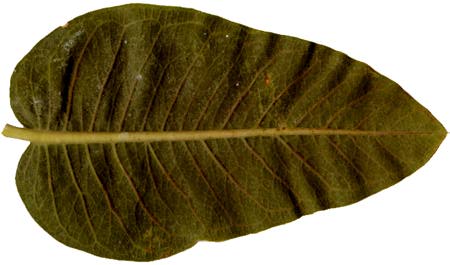 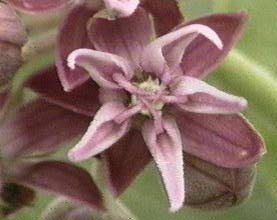
- Perennial herb from a deep rhizome
- 5-10 dm tall
- Leaves usually opposite; 8-20 cm long, 2.5-10 cm wide
- Flowers:purplish-rose
- Habitat: Sandy, loamy, or rocky soils on banks and flood plains of lakes, ponds, or waterways or moist areas in prairies
- Distribution:Great Plains except MO, sw IA, e 1/4 KS, e 1/3 OK; (s Can., Great Plains w to WA & w-cen CA, s to s NM)
Text from: Great Plains Association, 1986. Flora of the Great Plains. University Press of Kansas.
Asclepias stenophylla (Narrow-Leaf Milkweed)
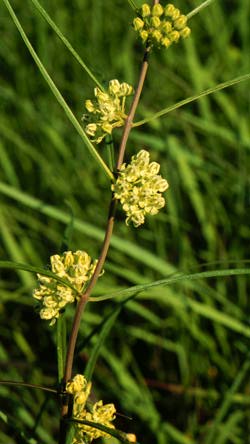  
- Perennial herb from a stout vertical rootstock
- 2-10dm tall
- leaves mostly alternate to subopposite, 8-18cm long, 1-5mm wide
- Flowers: greenish-white
- Habitat: Sandy or rocky calcareous soils of prairies
- Distribution: se MT, ne WY, w & s SD, NE, KS, MO, OK, TX (w IL to n-cen CO, s to w AR, TX)
Text from: Great Plains Association, 1986. Flora of the Great Plains. University Press of Kansas.
Asclepias sullivantii (Sullivant's Milkweed, Prairie Milkweed)
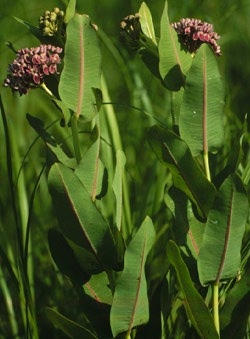 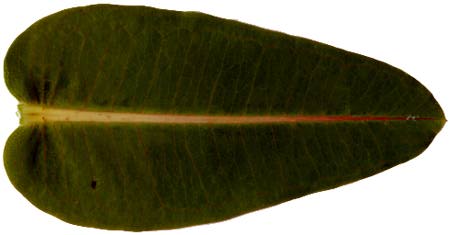 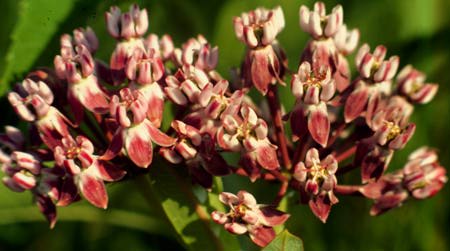 
- Perennial herb from deep fleshy rhizome
- 4-11 dm tall
- leaves opposite, 6-16 cm long, 2-9 cm wide, glabrous (smooth or hairless)
- Flowers: pinkish-rose to purple
- Habitat: Sandy, loamy or rocky calcareous soils of prairies and roadsides
- Distribution: MN, e ND, se SD, IA, e 1/2 NE & KS, MO, & OK; (s Can., OH, WI, IN, IL to Great Plains)
Text from: Great Plains Association, 1986. Flora of the Great Plains. University Press of Kansas.
Asclepias syriaca (Common Milkweed)
 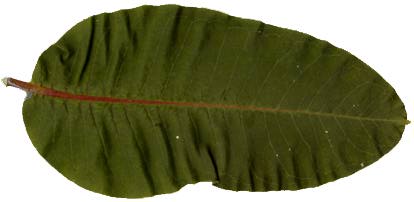   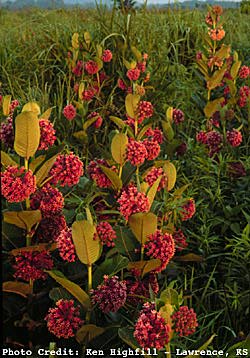
- Perennial herb from a deep rhizome
- 6-20 dm tall
- Leaves opposite and 10-19 cm long, 5-11 cm wide
- Flowers: dull purplish-pink to greenish white
- Habitat: Prairie, pastures, roadsides, and waste ground; sandy, clayey, or rocky calcareous soils of banks or flood plains
- Distribution: Great plains except MT,WY,CO,NM,TX; (s. Can., ME to ND, s to NC, nw GA, ne OK, & TX)
Text from: Great Plains Association, 1986. Flora of the Great Plains. University Press of Kansas.
Asclepias tuberosa (Butterfly Milkweed)
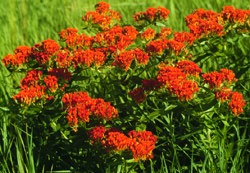 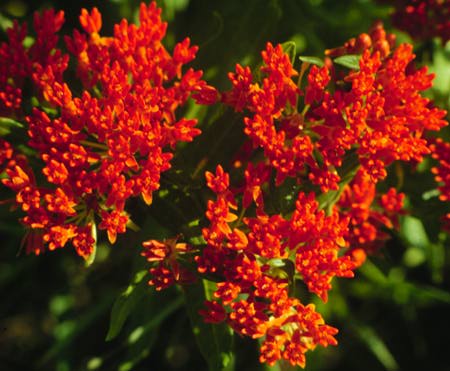  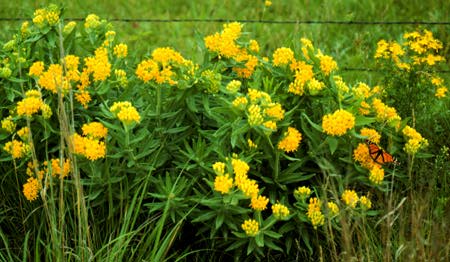 
There are two subspecies recognized by Woodson (Ann. Missouri Bot. Gard. 41:1-211. 1954) that occur in the Great Plains (although they are of questionable validity):
Asclepias tuberosa interior
- Perennial herb from a deep, woody root stock
- 3-9 dm tall
- leaves mostly alternate, 5-10 cm long, 0.7-2.3 cm wide
- Flowers: bright orange, rarely red or yellow
- Habitat: Sandy, loamy, or rocky calcareous soils of prairies, roadsides, & waste places
- Distribution: MN, e SD, IA, e 1/2 NE, e 2/3 KS, MO, OK, TX; (se Can., NY to MN, SD, s to MS & TX)
Asclepias tuberosa terminalis
- Perennial herb from a deep, woody root stock
- 3-9 dm tall
- leaves mostly alternate, 5-10cm long, 0.7-2.3cm wide
- Flowers: bright orange, rarely red or yellow
- Habitat: Sandy prairies and open woodlands
- Distribution: CO: El Paso, Pueblo, Yuma; MN: Stearns; NM: Union; OK: Cimarron; SD: Fall River; TX: Hutchinson; (MI, WI, CO, s to UT, AZ; n Mex.)
Text from: Great Plains Association, 1986. Flora of the Great Plains. University Press of Kansas.
Asclepias variegata (White Milkweed)
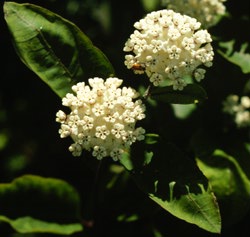 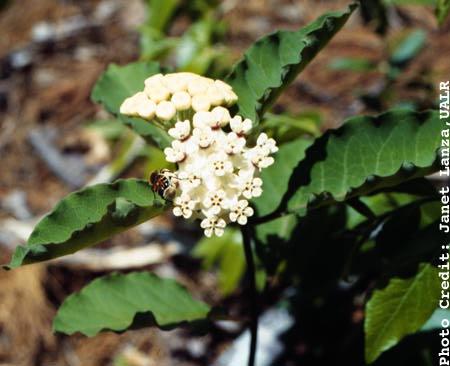 
- Perennial herb from a fleshy, fusiform rootstock, stems rather slender
- 3-12dm tall
- Leaves opposite; 5-12cm long, 1-3cm wide
- Flowers: Inflorescences usually solitary and terminal, flowers white, rather large and showy, snowball like in appearance, blooming from May to July
- Habitat:Thickets and open woods, usually in sandy or rocky soil
- Distribution: CT to n FL and westward to s MO and e TX
Text from: R.E. Woodson Jr., 1954. North American Species of Asclepias. Annals of the Missouri Botanical Garden.
Asclepias verticillata (Whorled Milkweed)
  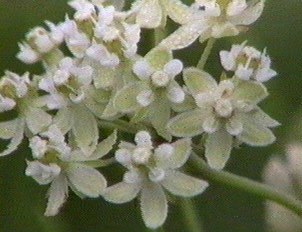
- Perennial herbs with a shallow root system
- 5-9dm tall
- Leaves mostly verticillate to subverticillate; 1.5-8cm long, 0.5-1.5mm wide
- Flowers:white to greenish-white
- Habitat:Sandy, clayey, or rocky calcareous soils of prairies, badlands, flood plains, & open woods
- Distribution:Great Plains except WY, CO; (s Can., MA to MT, s to FL & AZ)
Text from: Great Plains Association, 1986. Flora of the Great Plains. University Press of Kansas.
Asclepias viridiflora (Green Milkweed)
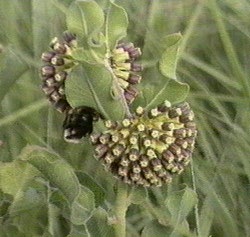  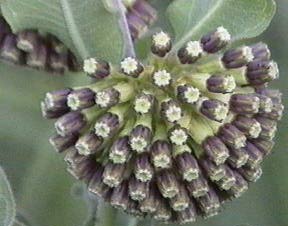 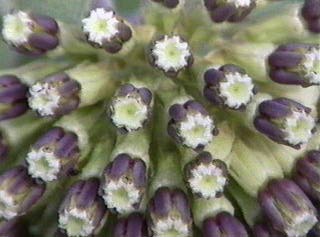
- Perennial herb from a vertical rootstock
- 1-6dm tall
- Leaves opposite or subopposite; 4-11cm long, 0.8-5cm wide
- Flowers: pale green
- Habitat: Sandy or rocky calcareous soils in prairies
- Distribution: Great Plains; (s Can., CT to MT, s to GA & AZ; ne Mex.)
Text from: Great Plains Association, 1986. Flora of the Great Plains. University Press of Kansas.
Asclepias viridis (Spider Milkweed)
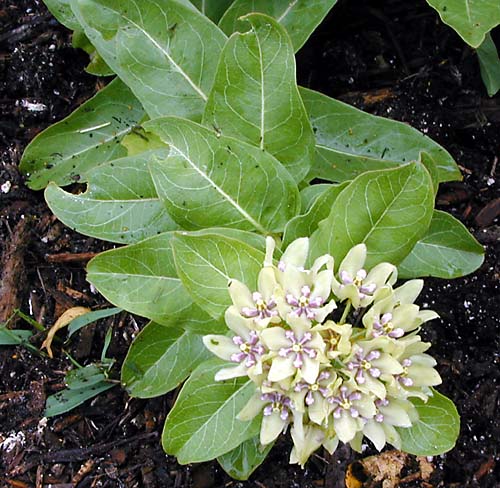 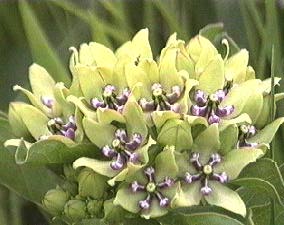 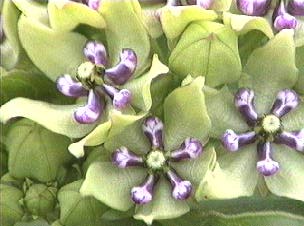   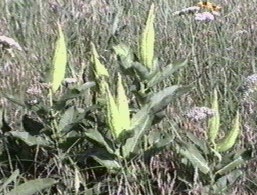
- Perennial herb from a thickened, cylindrical to fusiform, vertical rootstock
- 2.5-6.5dm tall
- leaves mostly alternate to subopposite, 5-12cm long, 1-5.5cm wide
- Flowers: greenish-white and reddish-purple
- Habitat: Sandy or rocky calcareous soils in prairies
- Distribution: se NE, MO, KS, OK; (OH to NE, s to FL & TX)
Text from: Great Plains Association, 1986. Flora of the Great Plains. University Press of Kansas.
|